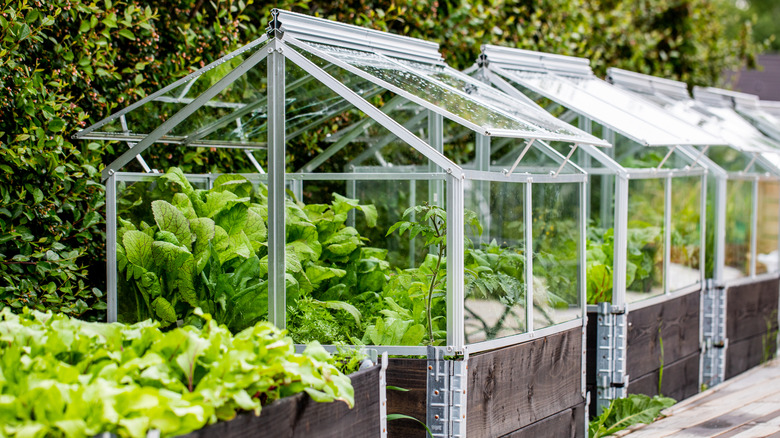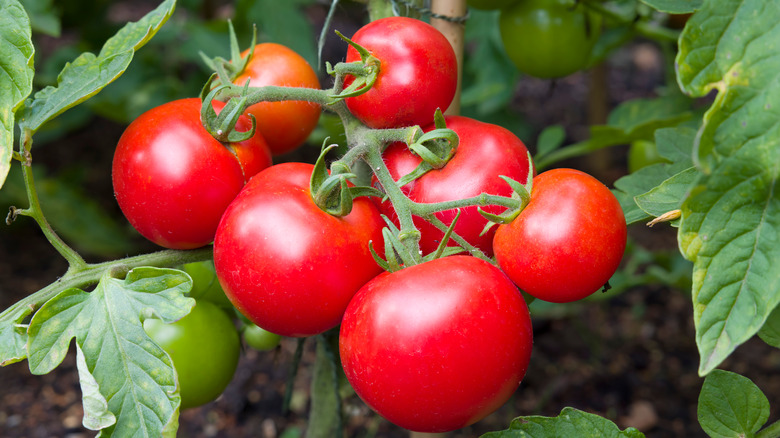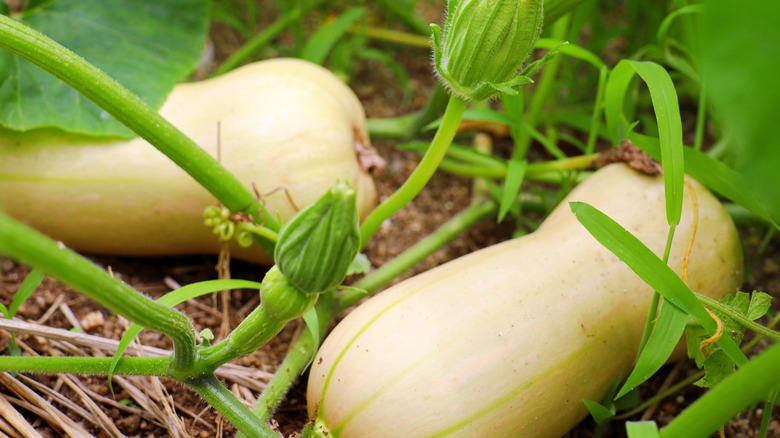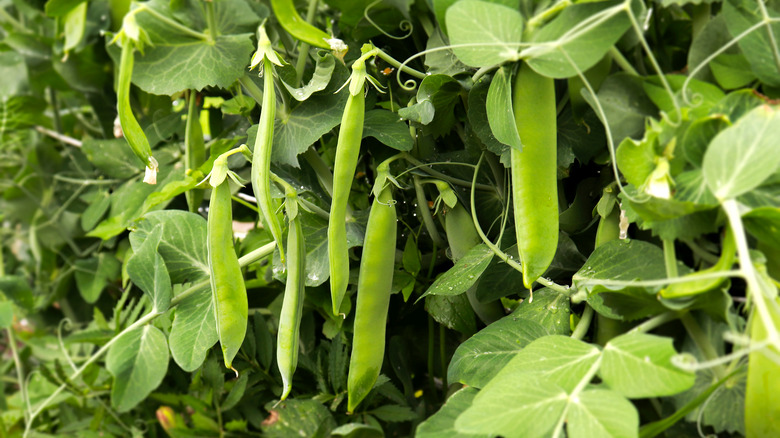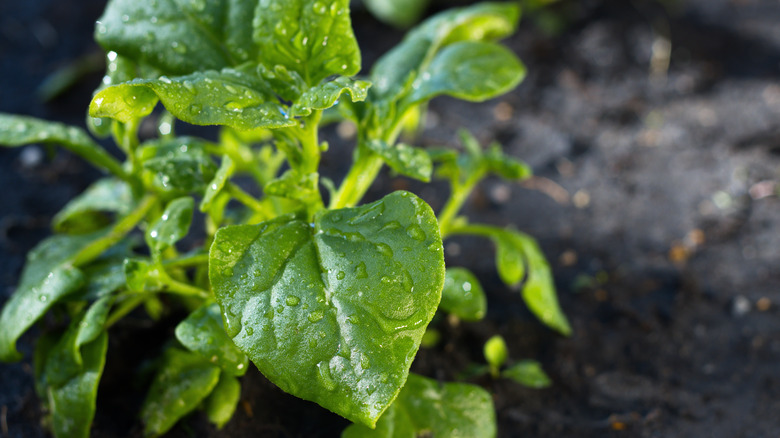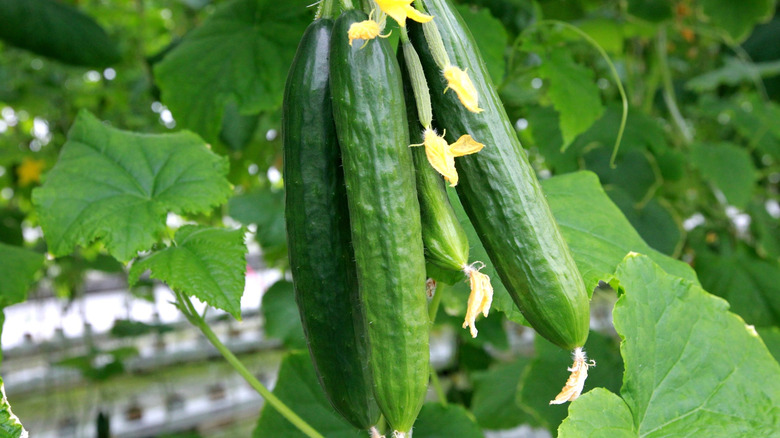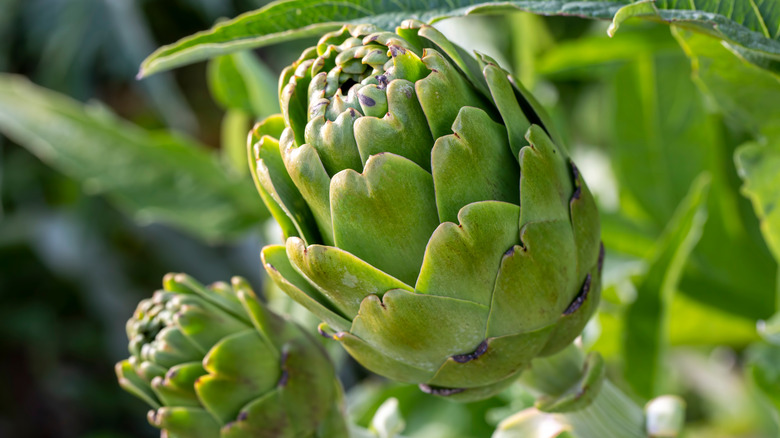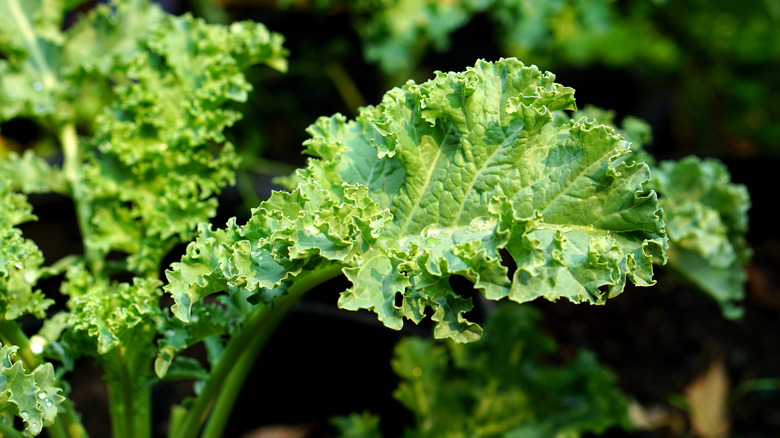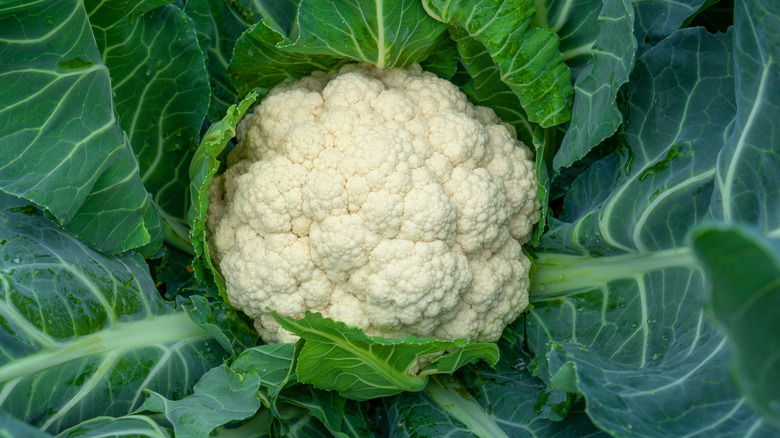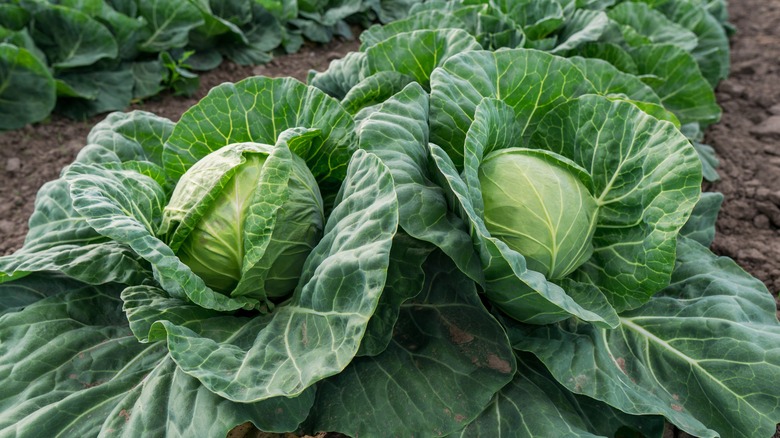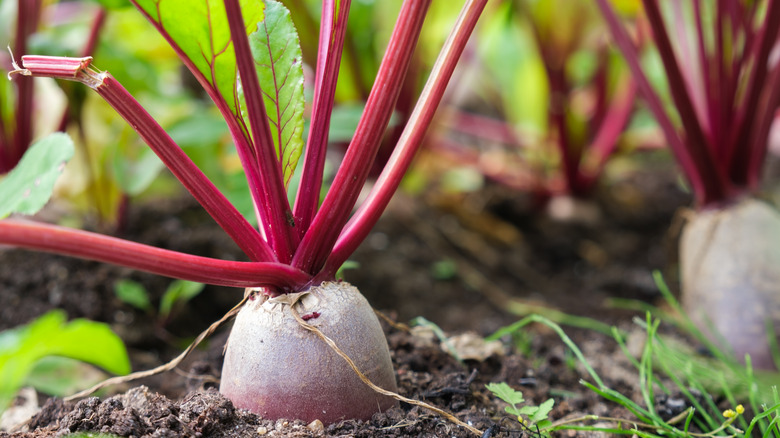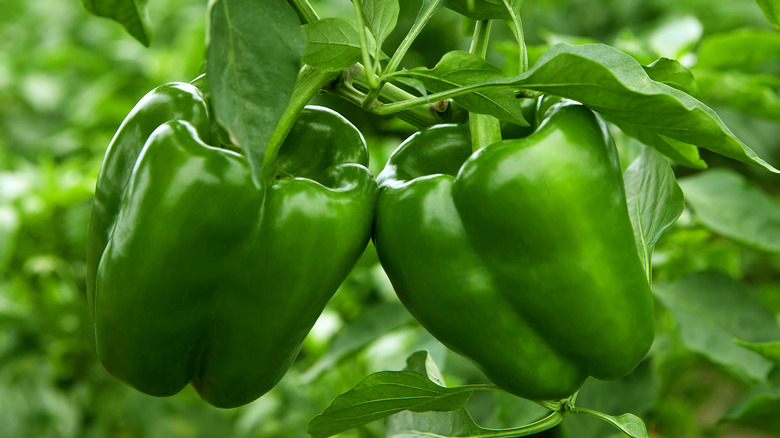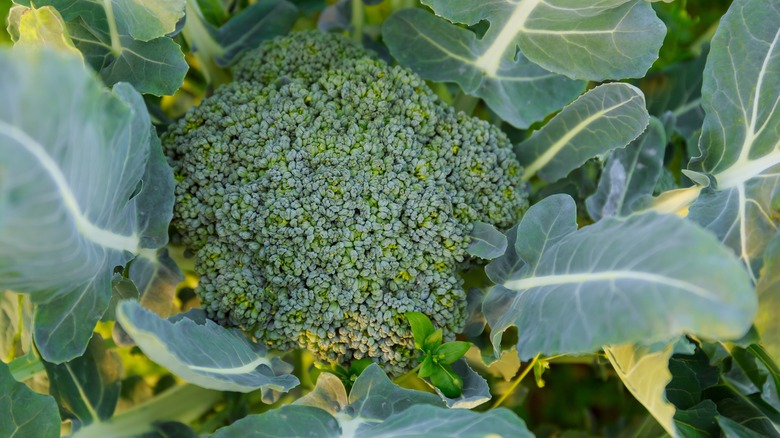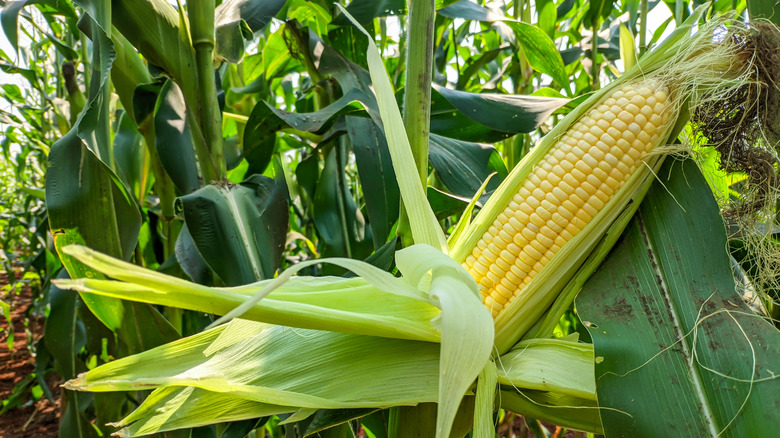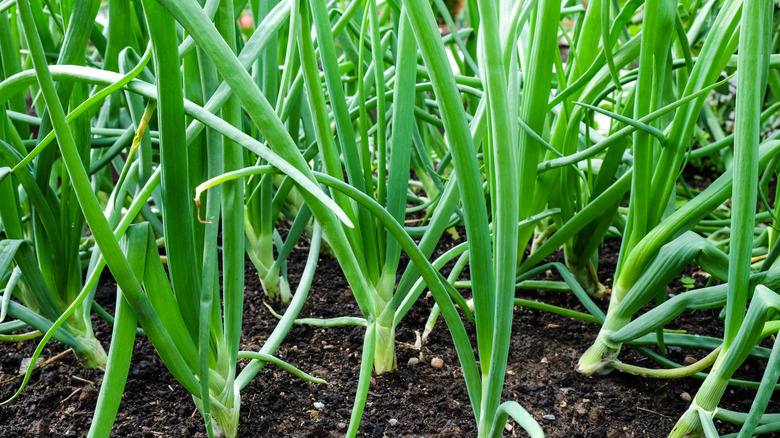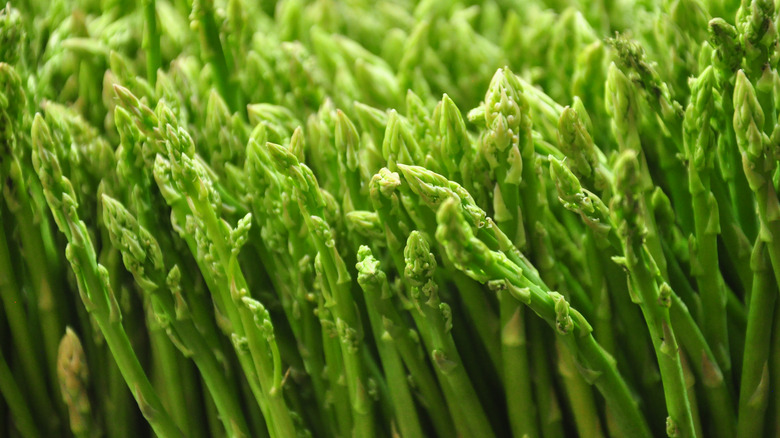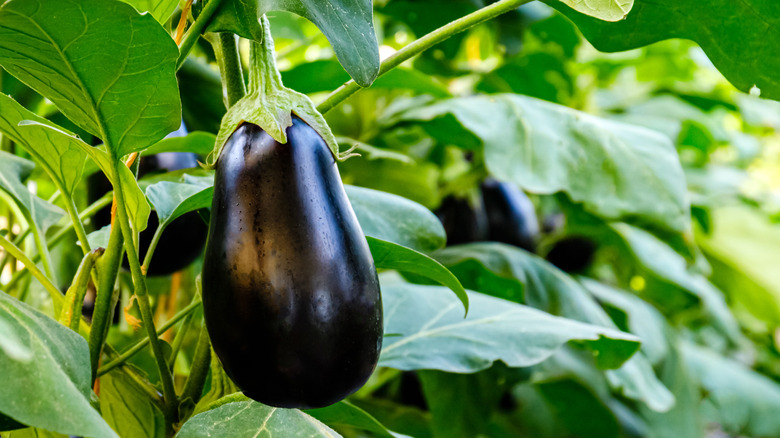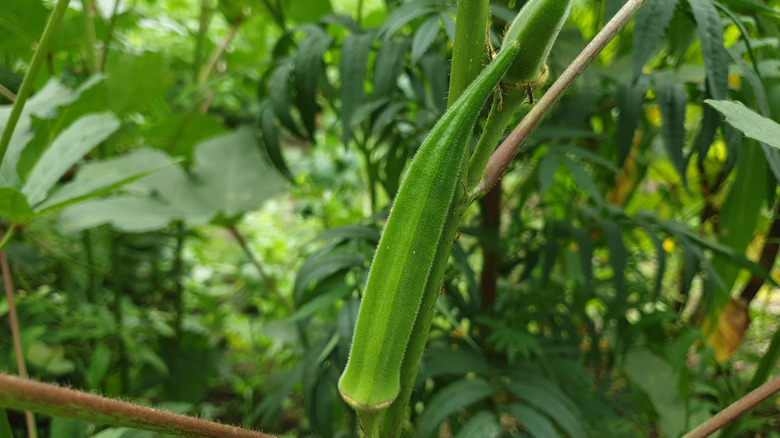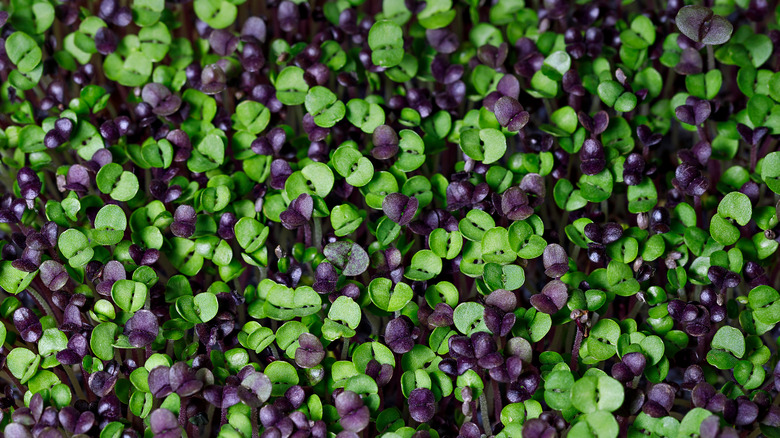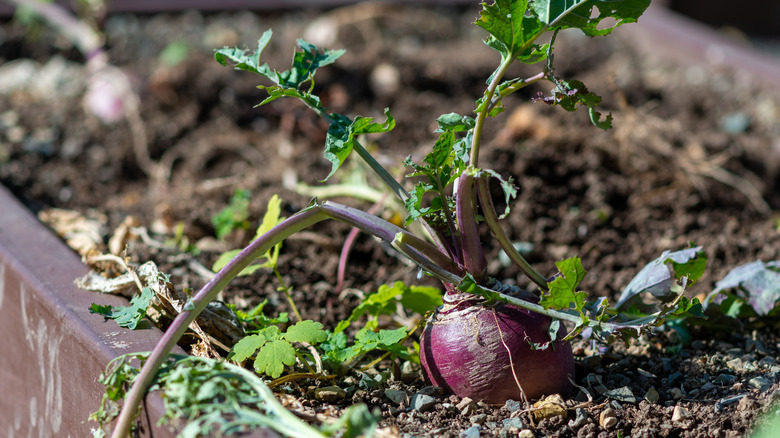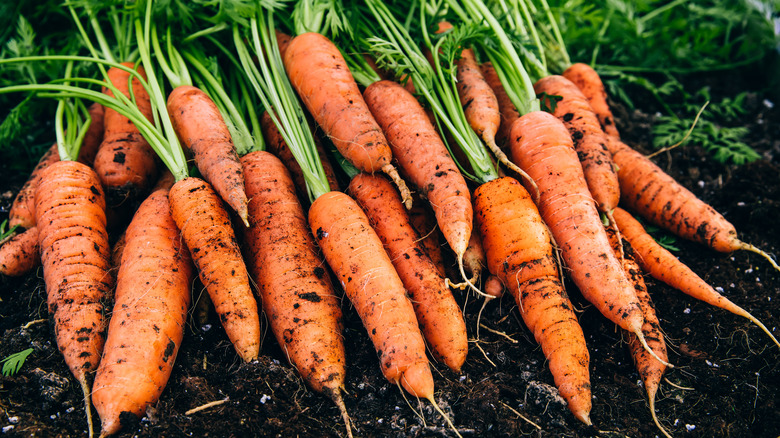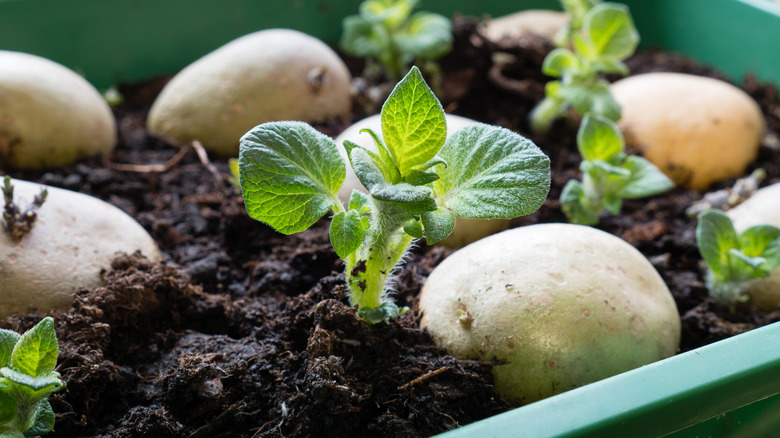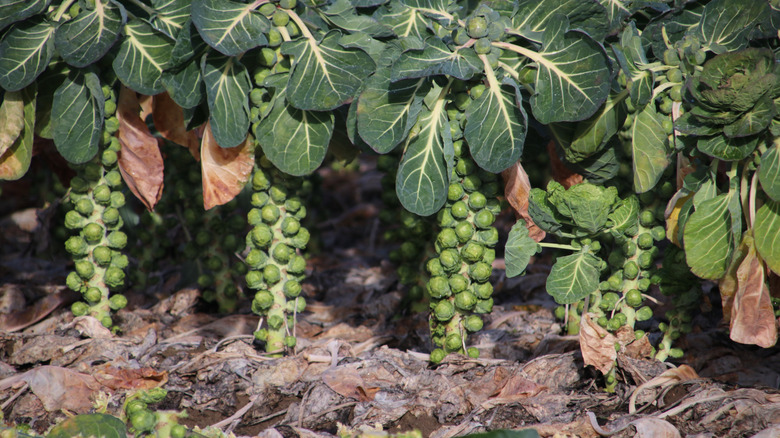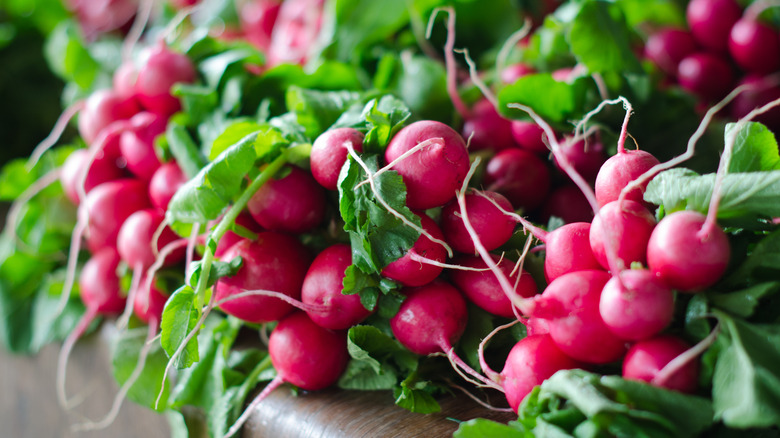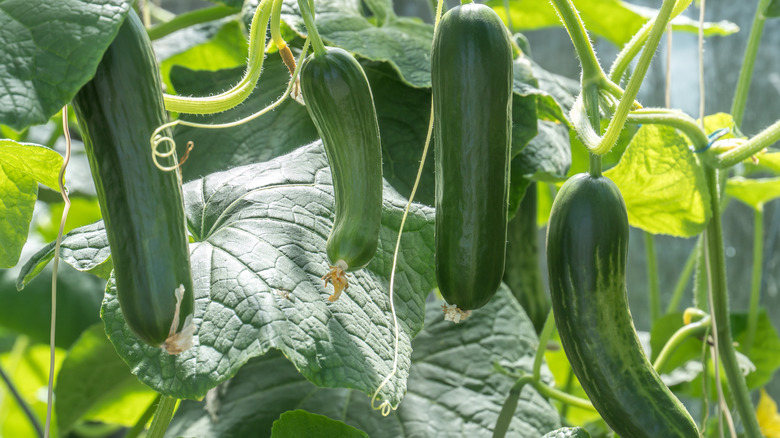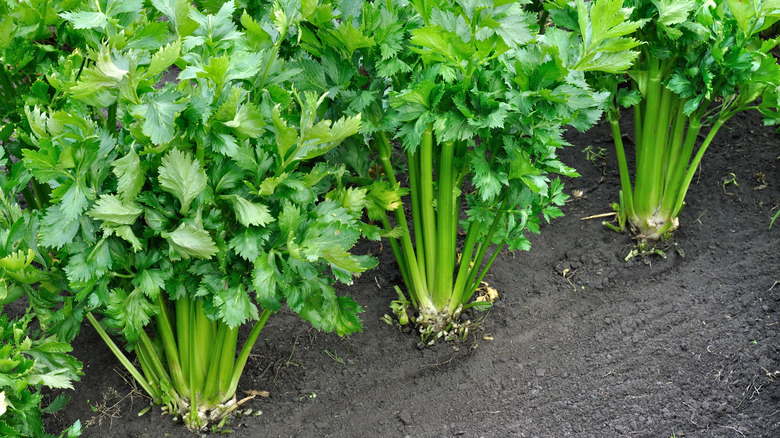Best Vegetables To Grow In Your Greenhouse
For the avid green thumb, spring and summer can bring plenty of joy. The feeling of fresh soil on your hands as you scatter the first seeds and the mouth-watering taste of vegetables right out of your garden can be both satisfying and delicious. But, when the chill sets in and you're preparing the veggie patches for the cold seasons ahead, there has to be a certain sadness knowing that you won't be able to garden again until next spring. However, building a greenhouse could keep the garden party going year-round. The costs involved in constructing a greenhouse can vary depending on how simple or complex you want the layout to be.
Whereas the amateur gardener may be looking for helpful hacks to DIY a greenhouse, a full-time gardener with a passion for agriculture may require the help of a professional to put their project into action. A greenhouse allows you to be able to control the heat, humidity, water distribution, and an even amount of sunlight all from one structure, according to Hope Botanical Gardens. The other benefits of having your own greenhouse are protecting the plants from harsh outdoor elements and harmful insects, birds, and rodents. Under one roof, you can have multiple types of soil in different plots and have the opportunity to grow just about anything. Now let's take a look at what vegetables would be perfect for growing in your greenhouse.
1. Tomatoes
Tomato plants need a good amount of sun as they grow best when temperatures are around 70 to 75 degrees Fahrenheit, according to Greenhouse Today. You want to make sure that the soil is rich in fertilizer or nutrients. Since the plants can grow up to 10 feet tall, you should have a stake beside them and tie the vines off every 6 inches so it doesn't collapse under their weight.
Bloom Season: Early spring
USDA Growing Zone: 5 through 8
Growing Conditions: Sunny
Soil Type: Acidic to neutral
Size: Up to 10 feet
2. Squash
Greenhouse Growing recommends starting with small pots and sowing one squash seed per pot. Squash love warm temperatures that never dip to frosty levels and fertilizer-rich soil. Once the seedlings have sprouted and outgrown their homes, they can be transported to your greenhouse. Ensure that they're planted with vegetables of the same likeness and have lots of room to grow as their leaves tend to take up space.
Bloom Season: Late spring, early summer
USDA Growing Zone: 2 through 11
Growing Conditions: Full sun
Soil Type: Slight acidity to neutral
Size: 1 to 3 feet
3. Beans
Bean seeds can be prepped for the soil by placing them in a plastic bag with a bit of water. Let them soak for up to 24 hours, which will help expedite germination. Beans need plenty of water, excellent warm soil, and about eight hours of sunshine a day, according to Greenhouse Today. The plants will grow tall and produce many pea pods, so you might need to tie them to a trellis break.
Bloom Season: Spring, summer
USDA Growing Zone: 5 through 11
Growing Conditions: Sunny
Soil Type: Slight acidity to neutral
Size: 2 to 15 feet
4. Spinach
With proper care, you should be able to grow a good amount of healthy vitamin-packed spinach year-round in a greenhouse. When growing, spinach requires a large amount of nutrient-rich soil and thrives when it has a pH of 6.5 to 7.5, according to Finest Greenhouse. When harvesting your spinach, you want to pick the leaves while they are young, as adult plants tend to taste fairly bitter, and if left too long, it will become quite inedible.
Bloom Season: Spring
USDA Growing Zone: 5 to 10
Growing Conditions: Sunny
Soil Type: Neutral
Size: 6 to 12 inches
5. Cucumbers
Cucumbers are not fans of frosty climates, so proper care inside a greenhouse could be just the thing to ensure a good yield of tasty vegetables. While growing, it could be a good idea to use a trellis to encourage vertical growth as this might help more cucumber shoots to sprout upwards, as per Greenhouse Emporium. Watering should be done often and in moderate amounts. Ensure plenty of sunshine, at least six hours a day.
Bloom Season: Summer
USDA Growing Zone: 4 through 12
Growing Conditions: Full sun
Soil Type: Slight acidity to neutral
Size: 6 to 8 feet
6. Artichoke
These vegetables can be grown from seeds, using the cuttings of another artichoke plant, or by reviving the dormant roots, according to Fine Gardening. If growing by seed, make sure to give the plant plenty of room as they tend to spread out, and it could help to use grow lights for the beginning stages. You should keep your artichoke plants 4 feet apart and provide plenty of nutrients in the soil.
Bloom Season: Summer
USDA Growing Zone: 7 to 11
Growing Conditions: Full sun
Soil Type: Slight acidity to neutral
Size: Up to 3 feet
7. Kale
Kale can be a breeze to grow in your greenhouse. A biennial plant, the life cycle of kale sets up roots and initial leaves in the first year; then, with the first frost, the leaves die and come back in the spring, as per Greenhouse Today. Producing tastier leaves after the frost, these plants can do well in colder temperatures which is ideal for those greenhouses in chillier climates.
Bloom Season: Late spring, early summer, fall
USDA Growing Zone: 8 to 10
Growing Conditions: Partial to full sun
Soil Type: Neutral to slightly alkaline
Size: 1 to 2 feet
8. Cauliflower
When growing cauliflower in your greenhouse, starting from seed in biodegradable containers can be beneficial. According to Gardening Tips, when the sprouts have been created, you can pop the container into well-moisturized soil not to break the fragile roots. Watering needs to be done regularly, being wary not to oversaturate the soil and drown the plant. It can take roughly 55 to 100 days for a full-fledged head to be ready.
Bloom Season: Spring
USDA Growing Zone: 2 through 11
Growing Conditions: Sunny
Soil Type: Slight acidity to neutral
Size: 12 to 30 inches
9. Cabbage
Cabbage thrives in a greenhouse with plenty of natural sunlight and rich, moist soil conditions. Make sure to space the plants, at least two feet apart from each other. Greenhouse Emporium also recommends that you plant them next to a bean crop, as cabbage generally uses up a lot of the essential minerals of the soil. In contrast, beans help to improve the nitrogen of the soil.
Bloom Season: Fall
USDA Growing Zone: 1 through 10
Growing Conditions: Sunny
Soil Type: Neutral
Size: 12 to 14 inches
10. Beets
To ensure a good beetroot crop in your greenhouse, you should plant in loosely packed and nutrient-rich soil. According to Backyard Sidekick, the soil needs to remain moist around the roots and shouldn't be allowed to dry out. To test, simply stick your finger into the soil by the roots to test the moisture level. This can help you to determine whether it is in good condition or needs watering.
Bloom Season: Late spring, fall
USDA Growing Zone: 2 to 11
Growing Conditions: Full to partial sun
Soil Type: Acidic to neutral
Size: 4 to 5 inches
11. Peppers
In the early stages of growing peppers, you get crispy green varieties, followed by yellow and orange peppers where the vitamin C content dramatically boosts, then finally, the sweet red peppers. The temperature must be closely monitored to grow your own successfully in a greenhouse. It is essential to keep the temperature between 25 to 28 degrees Celsius during the day and 16 to 18 degrees Celsius throughout the night, per the Greenhouse Planter.
Bloom Season: Summer
USDA Growing Zone: 8 to 10
Growing Conditions: Sunny
Soil Type: Slight acidity to neutral
Size: 20 inches to 6 feet
12. Broccoli
Broccoli should be planted in nutrient-packed soil with seeds spread out about 15 to 24 inches apart, then watered thoroughly, according to Garden Guides. Once the seeds start to sprout, make sure that any future watering is done at the bottom of the stalks and not on the head. Watering the head could lead to unusable broccoli. When they're ready to be harvested, simply cut the vegetable at the stalk, about half a foot under the head.
Bloom Season: Summer
USDA Growing Zone: 2 to 11
Growing Conditions: Sunny
Soil Type: Slight acidity to neutral
Size: up to 2.5 feet
13. Sweetcorn
Bring the goodness of corn home by dedicating some of your greenhouse space to growing your own. Make sure you have the room to accommodate tall corn stalks and soil that can stay moist and drain well. Also, the lighting has to be just right. So if you don't have one particularly sunny spot in your greenhouse, Greenhouse Emporium recommends that you need the assistance of grow lights to help you with the process.
Bloom Season: Summer
USDA Growing Zone: 4 to 8
Growing Conditions: Sunny
Soil Type: Slight acidity to neutral
Size: 6 to 8 feet
14. Green Onions
Ever left some green onions in the fridge for too long? You might have noticed that they can take on a life of their own and start to sprout. Whether you choose to grow from seeds or use the bottom clippings of a previously enjoyed onion, just ensure that they are getting up to 10 hours of sunshine a day in loosely packed soil, as per Access Garden Products. For the best results, do not overwater your onions.
Bloom Season: Summer
USDA Growing Zone: 6 through 9
Growing Conditions: Sunny
Soil Type: Neutral
Size: 1 to 3 feet
15. Asparagus
Growing greenhouse asparagus can be the gift that keeps on giving. These types of perennial veggies — if properly maintained — can keep your harvest of asparagus growing for up to 20 years, according to Old World Garden Farms. But first and foremost, choose the perfect sunny spot in your greenhouse before you start planting. Good soil free of pesky weeds and plenty of compost in the mix will offer a suitable base for growing better, tastier crops.
Bloom Season: Spring
USDA Growing Zone: 3 to 8
Growing Conditions: Sunny
Soil Type: Neutral
Size: 6 to 10 inches
16. Eggplant
Gardeners might be overzealous and plant many seeds, not realizing that eggplants can produce up to 10 fruits, per the Finest Greenhouse. These are hungry plants, so you want to make sure that the soil they're in has a nice helping of compost, soil nutrients, or fertilizer to help them grow. Also, eggplants need up to 5 hours of sunshine a day with adequate airflow, so the plant is not under unnecessary stress.
Bloom Season: Summer
USDA Growing Zone: 4 to 10
Growing Conditions: Sunny
Soil Type: Slight acidity to neutral
Size: 2 to 4 feet
17. Okra
Low in calories and rich in vitamin A, okra has been a staple in gumbos and soups across the United States. The Greenhouse Emporium recommends that you grow okra from seeds right in your greenhouse plot after soaking for up to 18 hours. Okra likes warmer climates, so keep the temperature to around 70 degrees Fahrenheit. When watering your okra, keep it to the base and not the leaves — this will ensure that no harmful fungus grows.
Bloom Season: Summer
USDA Growing Zone: 9 to 12
Growing Conditions: Sunny
Soil Type: Slight acidity to neutral
Size: 3 to 6 feet
18. Microgreens
Microgreens have become popular over the years with trendy restaurants as they utilize the tiny greens that grow from the tops of young vegetables. To successfully grow your microgreens in a greenhouse, you must plant your seeds properly. According to the Microgreens Corner, you want to make sure to place the seeds in the soil and press them gently into the dirt without burying them.
Bloom Season: Varies depending on the type of greens
USDA Growing Zone: Varies depending on the variety of greens
Growing Conditions: Sunny, partial shade
Soil Type: Moist, neutral
Size: 3 to 7 inches
19. Turnips
Turnips do best when grown in a plot with full sun exposure, but they also do well with partial shade, as per Gardening Know How. Plant the seeds in moist soil, and once covered, add plenty of water to start germination. To get an excellent crop throughout the season, try planting some seeds every 10 days. That way, it can outstretch your harvest and have you enjoying turnips for a more extended period.
Bloom Season: Spring and fall
USDA Growing Zone: 2 through 9
Growing Conditions: Sunny
Soil Type: Slight acidity to neutral
Size: 12 to 14 inches
20. Carrots
Nutritious and delicious carrots need rich, loose soil to encourage the roots to grow deep, according to the Greenhouse Emporium. That will help you to grow larger carrots once harvest time hits. When it comes to watering your crop, carrots grow best with moist soil. Make sure not to overwater as this could be detrimental and encourage fungus. Carrots can withstand colder temperatures, and some varieties are even resistant to pests which is a bonus.
Bloom Season: Spring or end of summer
USDA Growing Zone: 3 to 10
Growing Conditions: Sunny
Soil Type: Neutral
Size: 2 to 12 inches
21. Potatoes
For a simple way to grow greenhouse potatoes, try using those old spuds left at the bottom of your previous potato sack. Simply cut it so that there is at least one eye — the alien-like root growing out the surface — in every piece. Let it sit for 24 hours, then it should be ready to sow, according to the Greenhouse Emporium. Plant in a row 3 feet away from each other and water regularly without soaking the soil.
Bloom Season: Summer
USDA Growing Zone: 3 to 10
Growing Conditions: Sunny
Soil Type: Acidic
Size: Up to 40 inches
22. Brussels Sprouts
The mere mention of Brussels sprouts might send kids running and screaming from the kitchen, but growing your own sprouts can be rewarding. For best results, grow them in a greenhouse so you can be in charge of the soil and temperature control. Greenhouse Today suggests you use nitrogen-rich soil when growing from seeds. For colder temperatures indoors, water the sprouts twice a week, and for warmer temperatures, stick to a daily watering cycle.
Bloom Season: Fall
USDA Growing Zone: 3 through 9
Growing Conditions: Sunny
Soil Type: Neutral to slightly alkaline
Size: 2 to 3 feet
23. Radishes
Radishes can be a quick and easy vegetable to grow in your greenhouse. They need about six hours of sunshine a day while planted in moist compost-rich soil, according to Gardening Tips. However, because it's a colder climate-adapted plant, they don't mind a little shade. These vegetables grow best in temperatures around 10 to 21 degrees Celsius. Watering should be done carefully so the soil doesn't get too dry or too wet as it can affect the roots.
Bloom Season: Late spring, early summer
USDA Growing Zone: 6 and 7
Growing Conditions: Sunny
Soil Type: Neutral
Size: 4 to 14 inches
24. Zucchini
Zucchini is an excellent substitute for pasta noodles and a member of the squash family that tastes wonderful, either cooked or raw. Known to have a fairly short 50 to 60-day growing cycle, it is important to help pollinate your zucchini and allow plenty of airflow, according to the Greenhouse Emporium. In order to properly pollinate in a greenhouse, take the pollen dust from the male flower and sprinkle it onto the female for a successful yield.
Bloom Season: Summer
USDA Growing Zone: 3 through 9
Growing Conditions: Sunny
Soil Type: Slight acidity to neutral
Size: 2 to 5 feet
25. Celery
Celery is a cool-weather growing vegetable that's so versatile in the kitchen. To have a successful celery harvest, ensure the temperature stays between 70 and 75 degrees Fahrenheit during the day and 60 to 65 degrees Fahrenheit in the evenings, according to The Old Farmer's Almanac. The plant can't be drenched in water, but you want to water it often so the dirt remains moist. Also, ensure that the soil is topped off with organic-rich material.
Bloom Season: Summer, autumn
USDA Growing Zone: 2 to 10
Growing Conditions: Sunny, partial sun
Soil Type: Neutral
Size: 12 to 18 inches
